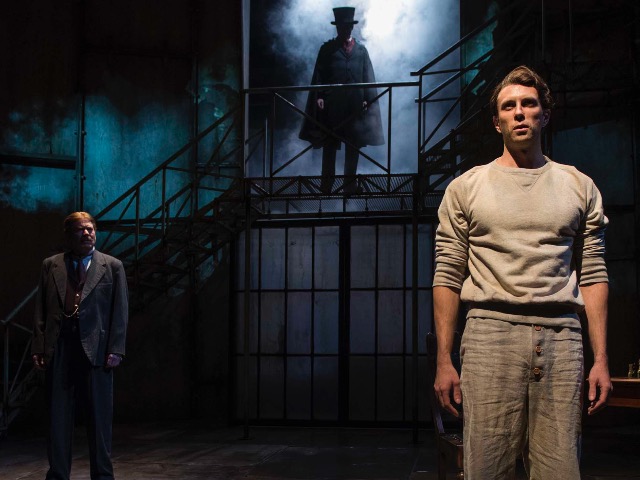In the Milwaukee Rep’s "Holmes and Watson," one of literature’s greatest sidekicks has a mystery to solve.
A woman has been found running mad across the moors. Taken to a remote island in Northern Scotland, three different men have come forward requesting to see her – and they all claim to be Sherlock Holmes. But the infamous British sleuth has been presumed dead for three years – ever since his showdown with his arch-nemesis Moriarty at Reichenbach Falls. Only Dr. Watson can determine which one of the men is Holmes and which ones are insane.
This chilling task has an equally unsettling backdrop: a fortress that was long used as a lighthouse, now abandoned and transformed to a makeshift asylum. As designed for the stage by Bill Clarke, it is extraordinarily versatile and evocative. A three story metal staircase resembling a fire escape forms a stark diagonal across the plain back wall.
The monolith is divided by a soaring column of windows, presumably where the lights – still hanging from an enormous gear over the audience – shone over the water on dark and perilous nights. These glass walls retract at key points to reveal scenes from the past. Particularly stunning is the repeated memory of Holmes and Moriarty’s last meeting by the falls, where one or both of them may have perished.

In another genius staging moment, black and white film is projected onto the enormous canvas of the blank wall, portraying trains coming and going, and other scenes that set the time period and the landscape beautifully.
As the play begins, Watson enters the asylum and immediately pieces together the circumstances, giving several chapters of background to the audience. The faithful partner from Baker Street, Norman Moses is a good storyteller and stays several steps ahead of us in interviewing the potentially unhinged Holmes impersonators and hatching a plan to reveal the real detective. As the Scottish doctor charged with caring for the lunatics, Mark Corkins is a poor conversational partner. He seems stiff and somewhat hemmed in by his brogue, but like the play itself, his character blossoms briefly in the final moments.
As the first of three patients claiming to be Sherlock, Ryan Imoff begins with a matter-of-fact, steady clip of observations, uttered as quickly as his brain can process them. For fans of the BBC series "Sherlock," he’s pleasantly reminiscent of Benedict Cumberbatch in the role. (Swoon.) The second patient (Grant Goodman) enters in a straitjacket warning that he’s dangerous – and he looks it, with unkempt hair, wild eyes and a penchant for erupting in screams when touched. Rex Young easily gives the most mesmerizing performance as the third patient. With his head shaved and his mouth hanging open, he presents a lost soul so traumatized that he is initially blind, deaf and mute. His several transformations are riveting.
Eric Damon Smith and Maggie Kettering both make nice choices as they morph into several distinct characters throughout the action of the play. And both also make triumphant reveals in the mystery’s last scenes.
Joseph Hanreddy’s direction uses the space exceptionally well, pulling inmates from under an iron grate on the stage floor, and having an inspector enter from a platform three stories in the air. As a frustrated viewer seated on the extreme sides of the theater for several Rep shows last season, I also noticed how adeptly Hanreddy moved the action around the playing area and created generous sightlines for the entire audience.
Unfortunately the best direction, most gifted acting and exceptional scenery doesn’t save "Holmes and Watson" from being a terrible bore. At only 80 minutes long, Jeffrey Hatcher’s script should keep us on the edge of our seats. Instead, it kept the opening night audience a bit confused and impatient. There are a dozen nice surprises at the play’s end, but getting there, through days of repetitive exposition, is a chore.







